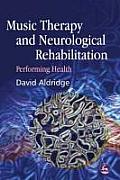 Aldridge, D. (ed),
Herkenrath, A. (2005). Music Therapy and
Neurological Rehabilitation. Chapter 6, London: Jessica Kingsley
Aldridge, D. (ed),
Herkenrath, A. (2005). Music Therapy and
Neurological Rehabilitation. Chapter 6, London: Jessica Kingsley
In Aldridge’s book on Music Therapy and Neurological
Rehabilitation, Ansgar Herkenrath, a German music therapist, contributes a
chapter based on qualitative research she has conducted of music therapy with
patients suffering from coma vigile or (persistent) vegetative state (PVS). In
medical terms, this population is seen as unable to perceive and communicate
with their environment.
The research was based on her work with PVS patients at a
long-term nursing institution for adult residents with severe neurological
handicaps in Haus Königsborn, in Unna Germany. Participants in her study were
between 20 and 50 years of age and had been in the PVS state for between 18
months and seven years. The book chapter expands the themes and issues related
to her study.Summary
PVS is mostly caused by brain damage due to severe craniocerebral injury trauma, cerebral haemorrhage or hypoxia. All descriptions of the state assume a functional failure of the cerebral cortex and complete loss of cognitive potentials while brainstem functions are maintained.
Herkenrath is candid about her experiences in working with PVS patients and knows that they are in direct contrast to the consensus among physicians that PVS patients are unable to perceive and react. Further, she acknowledges the provocative nature of her chapter title, and is forthright in her assumption about consciousness of a patient in PVS and the possibility of an encounter with this consciousness. The medium of encounter she describes is through a therapeutic relationship using music.
Therapeutic relationship
In PVS, there are pathological movements that are reflexive, and the external appearance alone does not indicate the quality of these movements. Rather, assessment of these reflexes requires situative and temporal context. In Herkenrath’s music therapy practice, she accesses situations that show changes in parameters of respiration, shifts in head and eyes towards the source of sounds and/or a variety of movements. She describes these situations as reactions, not reflexes. She defines reaction as a response to action that has been perceived and that leads to an emotional experience. Furthermore, a reaction must reveal a situative and a temporal reference in order to be distinguishable from reflex.
According to
Herkenrath, music provides both situative and temporal references for PVS
patients. An orientation of the head and eyes towards the source of a sound which
may change implies a situative connection. Temporal structure is inherent in
musical perception including beat and melodic structure i.e. phrase, cadence.
Herkenrath uses the Nordoff Robbins approach which
presupposes joint musical improvisation and participation between the therapist
and the client. A key element of her work uses rhythmic improvisation with
respiration or eyeblinks. She observes reactions in these movements based on appropriate
and intentional action in response.Consciousness
In this
chapter, Herkenrath spends time dealing with the subject of brain and mind,
perception and consciousness from a number of perspectives. In medicine, the
general opinion is that brain functionality is essential for consciousness.
Brain researchers call consciousness “the last big secret”. Neuroscientists
believe that consciousness cannot be associated with any definite brain region.
Philisophically and theologically from an historical perspective, consciousness
has been an integral part of the mind and soul. Ethically, the
definition of consciousness determines the direction of right to life
discussions.
Herkenrath discusses the concept of human existence and from her point of view, persons in PVS are unique human beings with individual needs and potentials. Human life, for her, is defined by more than neuronal processes in the brain.
Implications
Admittedly,
Herkenrath acknowledges the gaps in PVS prognoses. She calls for more research
both immediately following a PVS diagnosis and most importantly during the
longer term phase of PVS.
She
challenges our society to address the legal and ethical implications around the
rights of PVS patients. The implications around her findings around reactions
to music in PVS patients may have significant implications. Reaction from
music-making, as it is described in this chapter, implies recognition- that
there is someone else making music, and the fact that there is reaction,
illustrates the ability to differentiate between self and the other, a
self-consciousness.
Reflection
I am moved by the work of Ansgar Herkenrath. The integrity of her world view, that every form of life in its specific way is valuable, even PVS patients, is commendable. She has taken the time to grapple with the most basic of questions, namely, what is human existence? Her understanding is thoughtfully informed and comes from personal practice and experience.
The science Herkenrath suggests at the end of her chapter is happening here in Ontario. Dr. Adrian Owen is at the forefront of PVS and consciousness research and is the Canada Research in Excellence Chair of Neuroscience and Imaging at the University of Western Ontario. He has discovered through fMRI that brain centers concerned with mental imagining are activated when PVS patients are asked questions which may very well be the science to prove Herkenrath’s provocative 2005 suppositions. Here are some videos of Dr. Owen talking about his recent discoveries:
http://www.youtube.com/watch?v=Hz133pdwbOA&feature=related
What I would love to see in the future is an fMRI picture of brain activity during a music therapy session with Dr. Herkenrath and one of her PVS clients.
No comments:
Post a Comment